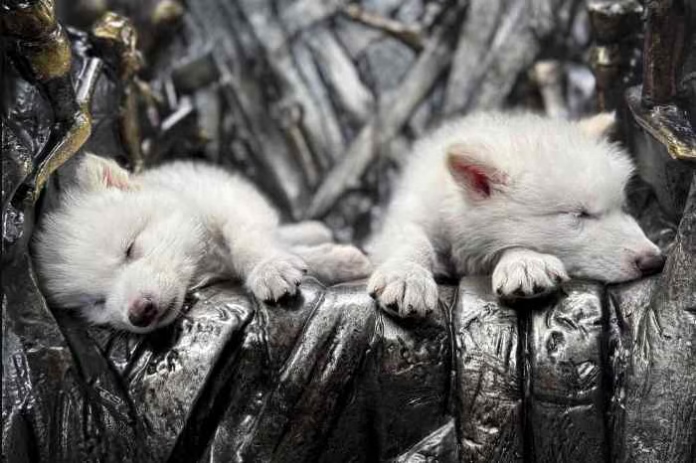The Mythical Comeback: What’s Really Going On?
Imagine walking through a snowy forest and spotting a creature that looks like it stepped straight out of the Ice Age. In early 2025, social media was set ablaze with claims that the dire wolf an extinct predator that last walked the Earth over 10,000 years ago had been resurrected. Photos of massive pups named Romulus, Remus, and Khaleesi were widely shared, supposedly the first dire wolves born in modern times.
The internet quickly celebrated what seemed like a real world Jurassic Park moment. But is it true? Has science really managed to bring back the dire wolf, or are we being misled by sensational headlines and speculative biotech?

In this article, we’ll break down:
- What dire wolves actually were, and why they went extinct
- The genetic truth behind the recent claims
- What scientists say about de-extinction
- The line between scientific advancement and sci-fi fantasy
Let’s separate facts from fiction and explore whether this legendary predator has truly returned or if it’s all just smoke and mirrors.
What Were Dire Wolves and Why Did They Disappear?

Ancient Giants of North America
- Species Name: Aenocyon dirus
- Extinction Timeline: Around 13,000 years ago
- Primary Habitat: North and Central America
Dire wolves were massive carnivores, larger and more muscular than modern gray wolves. They roamed Pleistocene landscapes and likely hunted in packs. With powerful jaws and strong bodies, they preyed on large mammals like bison and camels.
However, a mix of climate change and dwindling prey possibly worsened by human expansion led to their extinction during the Quaternary extinction event.
🧬 Fact: Genetic studies show dire wolves diverged from modern wolves over 5 million years ago, making them a completely separate lineage.
The Claim: Have Scientists Really Revived Dire Wolves?

The Headlines That Went Viral
In 2025, a company named Colossal Biosciences claimed to have engineered pups with traits reminiscent of dire wolves. These genetically modified canids were said to be the result of altering gray wolf DNA to bring back extinct features larger size, robust skulls, white coats.
But experts quickly pushed back.
What the Science Actually Says
- No ancient dire wolf DNA was used because none has been successfully recovered.
- The new pups are genetically modified gray wolves, not true dire wolves.
- De-extinction requires viable DNA from the extinct species something we currently don’t have for Aenocyon dirus.
So while the engineered wolves may look like dire wolves, they are not genetically authentic revivals.
🔬 Statistic: Dire wolves are genetically closer to African jackals than modern wolves. They cannot interbreed with modern wolves due to their deep divergence.
What Is De-Extinction and Is It Really Possible?

Understanding the Technology
De-extinction refers to the process of bringing extinct species back using genetics, cloning, or selective breeding. The most well known attempts include:
- The woolly mammoth (through Asian elephant DNA)
- The passenger pigeon (via modern pigeons)
- The Pyrenean ibex (briefly cloned in 2003)
But de-extinction is more complex than headlines make it seem. To truly resurrect a species:
- Intact DNA must exist
- A closely related surrogate species must be available
- The habitat and ecosystem must still support the revived species
For dire wolves, none of these criteria are fully met.
Media Hype vs. Scientific Reality

Why the Confusion?
Popular culture, especially shows like Game of Thrones, has turned the dire wolf into a symbol of power and mystery. This fascination fuels public excitement but also misinformation.
The media often oversimplifies scientific breakthroughs, framing genetically modified canines as “revived dire wolves” without considering the genetic, ecological, and ethical nuances.
The Verdict from Experts
Dr. Angela Perri, a leading zooarchaeologist, stated:
“What’s been created is an engineered wolf, not a true resurrection of the dire wolf lineage.”
Ethical Questions and the Future of De-Extinction
Should We Bring Back Extinct Species?
Even if it becomes technically possible, de-extinction raises major concerns:
- Ecosystem Disruption: Would the reintroduced species fit into modern ecosystems?
- Animal Welfare: Are the engineered creatures suffering?
- Moral Priorities: Should we focus on saving endangered species instead?
In Islam, ethical treatment of animals is paramount. Creating life unnaturally must be approached with caution and deep reflection. We are stewards of Earth not its re-creators.
Conclusion: Has the Dire Wolf Been Brought Back?
The short answer is no the dire wolf has not been brought back from extinction. While the birth of genetically engineered pups resembling the dire wolf is a remarkable feat, it is not true de-extinction.
The public fascination with ancient predators is understandable, but we must distinguish scientific advancement from sensational storytelling. As Muslims and seekers of truth, it is our duty to approach such claims critically, respecting both science and ethics.
Let your curiosity roam, but always keep your reason and values by your side.
What Do You Think?
- Should scientists pursue de-extinction?
- Would reviving ancient predators benefit or harm our world?
💬 Share your thoughts in the comments below and tag a friend who’s fascinated by prehistoric creatures!


